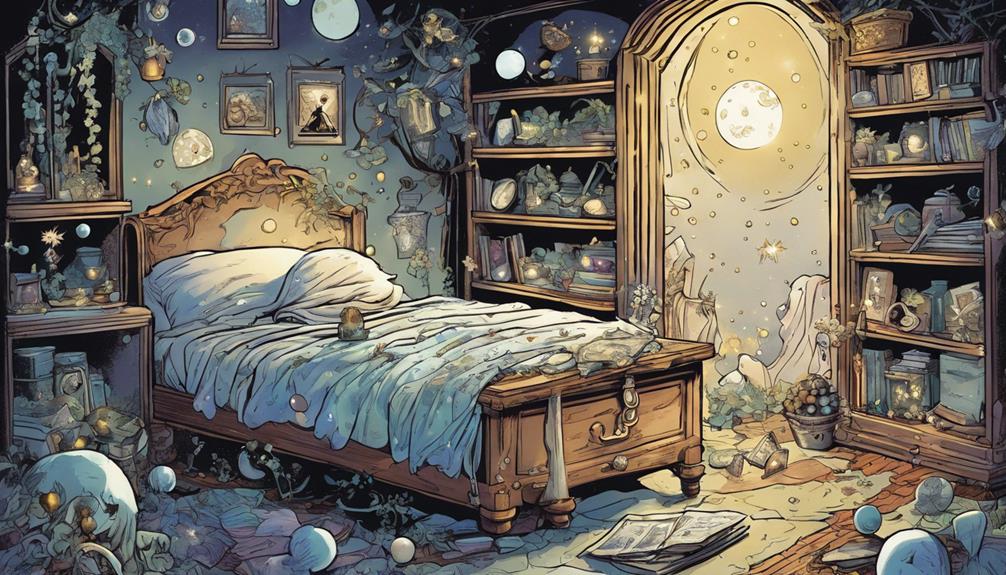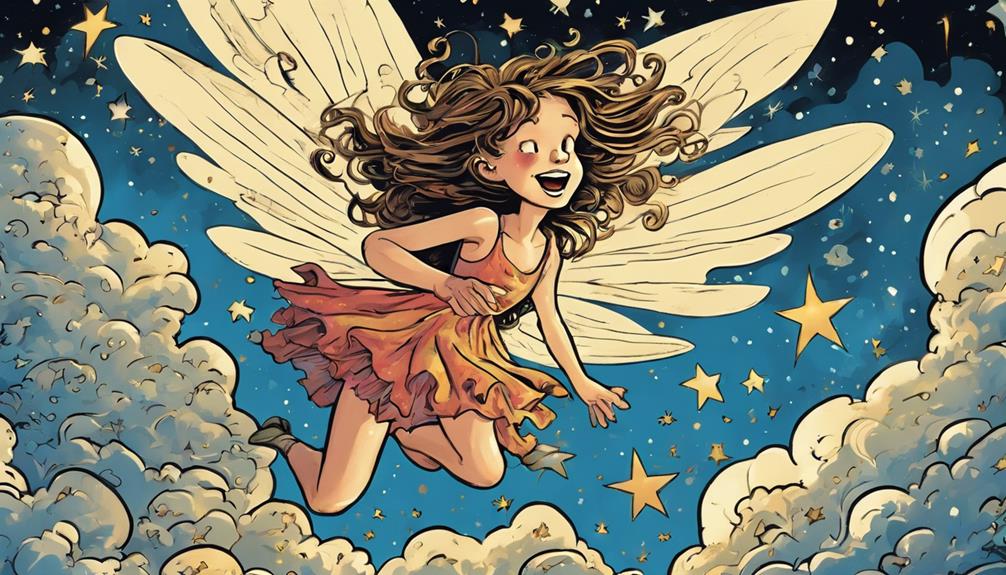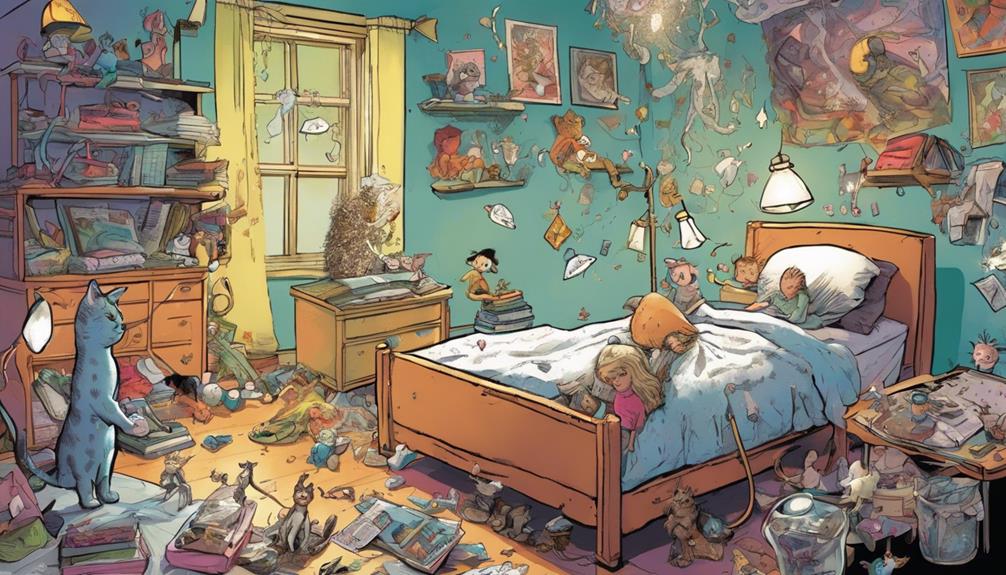The Tooth Fairy's biggest secret is her magical world where lost teeth become treasures. Every night, she collects them with the help of her mythical team, crafting beautiful items like necklaces from them. This tradition sparks excitement and joy in children, but as they grow, they might face the truth behind the magic. They experience a mix of confusion and acceptance that fosters their personal growth. The joy of the Tooth Fairy also varies across cultures, revealing unique customs that enhance family bonds. There's so much more to uncover about her enchanting world that'll spark your curiosity.
Key Takeaways
- The Tooth Fairy collects lost teeth to craft magical items, contributing to the sense of wonder surrounding this childhood tradition.
- She operates with a team of mythical helpers, allowing her to collect teeth from millions of homes in a single night.
- The transformation of teeth into treasures symbolizes the importance of childhood imagination and the joy of growing up.
- Cultural variations, like Ratoncito Pérez, reveal different secrets and customs surrounding tooth-related rituals across the globe.
The Magic of Childhood Traditions

The Tooth Fairy tradition brings excitement and wonder to childhood, as you enthusiastically anticipate the arrival of a magical exchange beneath your pillow. This cherished ritual marks a significant milestone, turning the often emotional experience of losing teeth into a joyful celebration. You place your lost tooth under your pillow, imagining the Tooth Fairy flitting in during the night, leaving behind coins or small gifts as tokens of her visit.
Across various cultures, you'll find unique interpretations of this tradition, like the Tooth Mouse in Spain and Latin America. These variations showcase the global embrace of childhood magic, ensuring that the thrill of losing a tooth is universally special. Engaging in Tooth Fairy rituals sparks your imagination, allowing you to revel in the anticipation of what surprises might await you in the morning.
As parents play an essential role in perpetuating this magic, they help create lasting memories that enhance family bonding. The excitement surrounding the Tooth Fairy not only makes losing teeth a fun adventure but also fosters a sense of wonder that enriches your childhood traditions, making each tooth lost a special occasion to remember.
Emotional Journey of Disillusionment

Steering the emotional journey of disillusionment can be challenging for children as they confront the reality behind the Tooth Fairy myth. When you played along with the magic, your child likely felt joy and wonder. However, discovering the truth often brings sadness and embarrassment, prompting strong emotional responses.
| Stage of Disillusionment | Emotional Response | Parental Guidance |
|---|---|---|
| Initial Belief | Joy and excitement | Celebrate the magic |
| Discovery of Truth | Sadness and embarrassment | Offer reassurance |
| Processing Reality | Confusion and trust issues | Engage in open dialogue |
| Acceptance | Understanding and growth | Share personal stories |
| Moving Forward | Resilience and maturity | Foster curiosity |
It's essential for you, as a parent, to provide emotional support during this process. Children may feel conflicted about their trust in you as they navigate their feelings of disillusionment. By fostering open communication, you help ease their distress, allowing them to shift from belief to understanding more smoothly. This emotional journey can shape their perceptions of honesty in your relationship, paving the way for deeper connections in the future.
Conversations About Belief and Reality

Steering conversations about belief and reality can feel intimidating, but it's an important step in helping your child grow emotionally and intellectually.
When your child loses their first tooth, it's a perfect opportunity to discuss the concept of the Tooth Fairy. Instead of simply confirming or denying the existence of magical figures, ask your child what they believe. This approach invites them to express their thoughts and feelings, allowing you to gauge their understanding of magic versus reality.
As your child ages, their ability to question these beliefs will deepen. The key is to maintain an open dialogue. Let them know it's okay to wonder about these figures and that you're there to help them navigate those feelings. If they express disappointment or confusion, reassure them that it's a natural part of growing up.
You can also share family traditions, making the conversation more relatable. By fostering ongoing discussions, you allow your child to adapt gradually while keeping their sense of imagination alive.
Ultimately, these conversations can strengthen trust in your relationship, allowing your child to feel secure as they explore the balance between belief and reality.
Cultural Perspectives on Tooth Fairies

Exploring how different cultures celebrate the loss of a tooth reveals fascinating variations in traditions, each reflecting unique beliefs and practices around this common childhood experience.
In Western cultures, you might be familiar with the Tooth Fairy, who exchanges your lost tooth for money or small gifts. However, if you look beyond these borders, you'll find diverse customs. For instance, in Spain and parts of Latin America, children enthusiastically await Ratoncito Pérez, a mouse that takes their lost tooth and leaves behind a treat.
In Greece, kids take a different approach: they throw their lost teeth onto the roof, believing it brings good luck. These traditions, while varying, all emphasize the importance of losing a tooth, often celebrated every year as children grow up.
The global market for these tooth-related rituals has expanded considerably, exceeding half a billion dollars, as families everywhere engage in these age-old customs. Each culture's unique way of celebrating tooth loss not only makes the experience memorable for children but also strengthens familial bonds and cultural identity.
The Tooth Fairy's Hidden World

In the enchanting territory of the Tooth Fairy, lost teeth are transformed into magical treasures that fuel her whimsical world. Here, every tooth serves a purpose, contributing to the vibrant energy that sustains her domain. You might wonder what she does with those tiny teeth. Well, there's a little bit of magic at play!
Consider these fascinating aspects of the Tooth Fairy's hidden world:
- Magical Items: She crafts necklaces and tools from the teeth, each imbued with unique powers.
- Cultural Lore: In different cultures, she creates Halloween disguises and other fanciful artifacts.
- Team of Helpers: The Tooth Fairy isn't alone—mythical creatures assist her in gathering teeth from children worldwide.
- Meticulous Planning: To visit millions of homes in one night, she relies on a blend of magic and careful organization.
Frequently Asked Questions
How to Answer What the Tooth Fairy Does With Teeth?
When kids ask what the Tooth Fairy does with teeth, you can spark their imagination by suggesting she crafts magical items or whimsical decorations, turning their lost teeth into treasures for her enchanting fairy domain.
What Is the Real Story of the Tooth Fairy?
The real story of the Tooth Fairy blends folklore and childhood fantasy. You place a tooth under your pillow, and she exchanges it for a small reward, symbolizing growth and the magic of growing up.
How to Explain the Tooth Fairy Isn't Real?
Imagine a magical night, sparkles in the air as you place your tooth under the pillow. You can gently explain that the Tooth Fairy's a fun tradition, created by parents to celebrate your special moments.
What Is the Tooth Fairy Story About?
The Tooth Fairy story's about a magical figure who visits while you sleep, exchanging lost teeth for coins or small gifts. It symbolizes growing up, sparking imagination and making the experience of losing teeth more exciting.
Is the Tooth Fairy’s Secret Life Related to Why She’s Been Hiding All These Years?
Many people have wondered about the tooth fairy’s hidden activities and why she’s been hiding all these years. Some say she leads a secret life, choosing to remain elusive to protect her magical powers. Others believe she simply prefers the mystery. Whatever the reason, her presence remains a cherished childhood tradition. Many children are curious about the tooth fairy’s hidden home, wondering what it looks like and where it might be located. Some have even tried to catch a glimpse of it, but the tooth fairy’s residence remains a well-kept secret. Regardless of the speculation, the tooth fairy continues to bring joy and excitement to children around the world with her timeless tradition. As rumors continue to swirl about the tooth fairy’s mysterious activities, some have suggested that she may be involved in global tooth fairy operations, using her magical abilities to exchange teeth for money in every corner of the world. Whether or not there is any truth to these claims, there’s no denying the widespread impact of the tooth fairy tradition on children’s lives. From leaving notes and gifts to sharing stories and spreading wonder, the tooth fairy’s influence reaches far and wide, making her hidden life all the more intriguing.
Conclusion
As you lay in bed, the soft glow of the moonlight dances across your room, and you clutch your precious tooth beneath your pillow.
You realize the magic isn't just in the fairy's visits. It's in the laughter, the stories, and the wonder that fills childhood.
Even as the truth unfolds like an old, cherished tale, the memories and warmth of those cozy nights linger.
They remind you that belief, in all its forms, can spark joy that lasts a lifetime.









